V květnu 2024 uplynulo 20 let od největšího rozšíření EU, v němž přistoupilo 10 zemí včetně České republiky. V oblasti výzkumu a inovací došlo k výraznému zlepšení výkonnosti, avšak ne ve všech oblastech. Touto otázkou se zabývá evropský portál Science Business, s nímž portál Vědavýzkum.cz navazuje partnerství.
The data show that great progress has been made in improving research and innovation systems in that time, with more public money being pumped in, more international scientific collaboration, and more private investment.
Some countries, such as Estonia and Lithuania, have made huge strides and are now close to reaching EU averages on several metrics. Despite this, a general performance gap between the EU’s newer and older members still exists and some countries’ public R&D expenditure has stagnated in the past decade.
Here, we dig into the numbers to see what has changed for the 10 countries in twenty years of EU membership. It is worth noting that while the data covers the period since they joined, EU membership is not necessarily the main reason behind the changes, rather one of the factors.
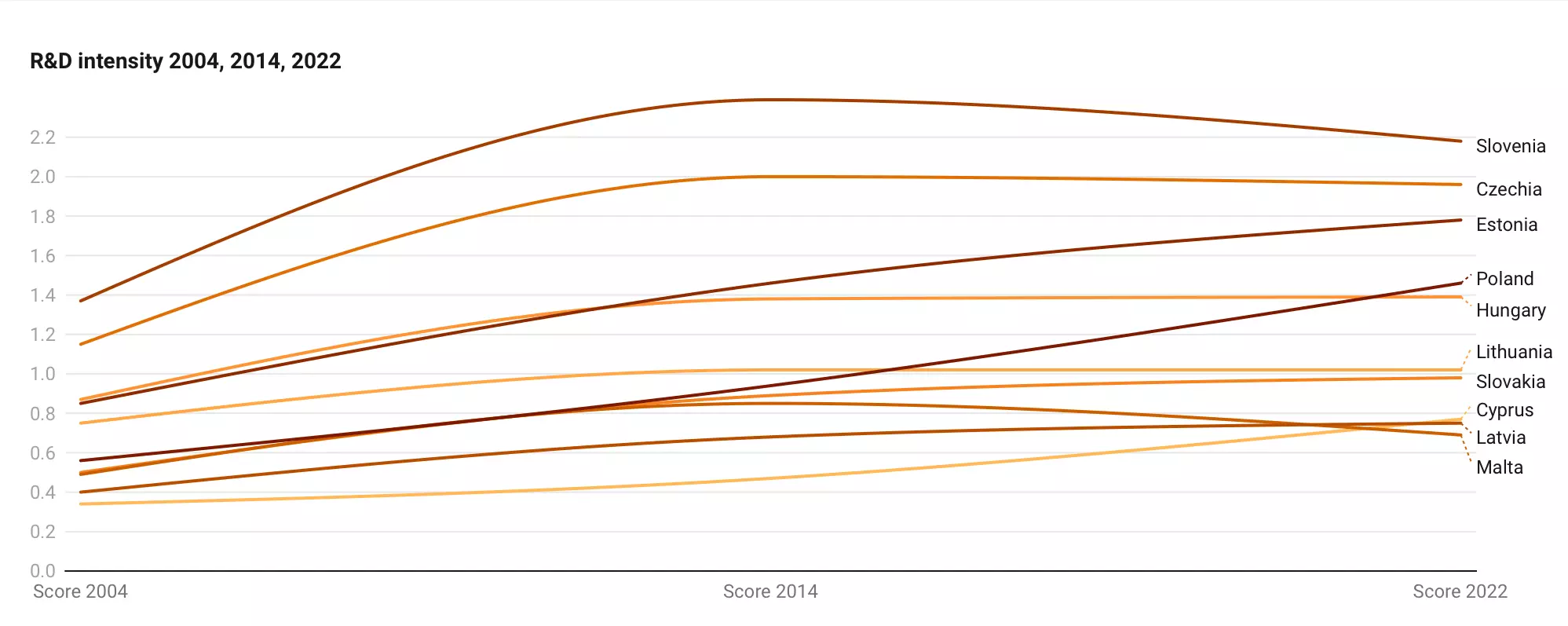 R&D intensity is the public R&D expenditure as a percentage of the gross domestic product
R&D intensity is the public R&D expenditure as a percentage of the gross domestic product
Source: European Commission / Get the data / Created with Datawrapper
When it comes to strong R&I performance, there is nothing like money. It is no secret that the EU countries with the strongest research ecosystems are also the ones that pump in the most funding. An easy way to compare countries on this is to look at what proportion of their GDP they put towards research and development, a metric known as R&D intensity.
All of the 10 countries that joined the EU in 2004 have since increased public spending on R&D. The biggest change has been in Poland, where the government went from spending 0.56% of the GDP on R&D in 2004, to 1.46% in 2022.
Despite across-the-board improvements since 2004, R&D intensity has dropped in three countries since 2014 – Czechia, Malta and Slovenia – and stagnated in two others – Hungary and Lithuania.
This is against the backdrop of the EU setting a goal in 2003 for all member states to increase their R&D intensity to 3% of their GDP. In fact, the EU average R&D intensity fell from 2.27% in 2021 to 2.22% in 2022.
R&D intensity, while useful for comparing public investment into research, does not take into account the fact that countries can still increase their R&D spending without it accounting for a larger proportion of GDP.
It is worth noting that the economies of all 10 countries that joined the EU in 2004 have grown, particularly in Estonia, Lithuania and Poland.
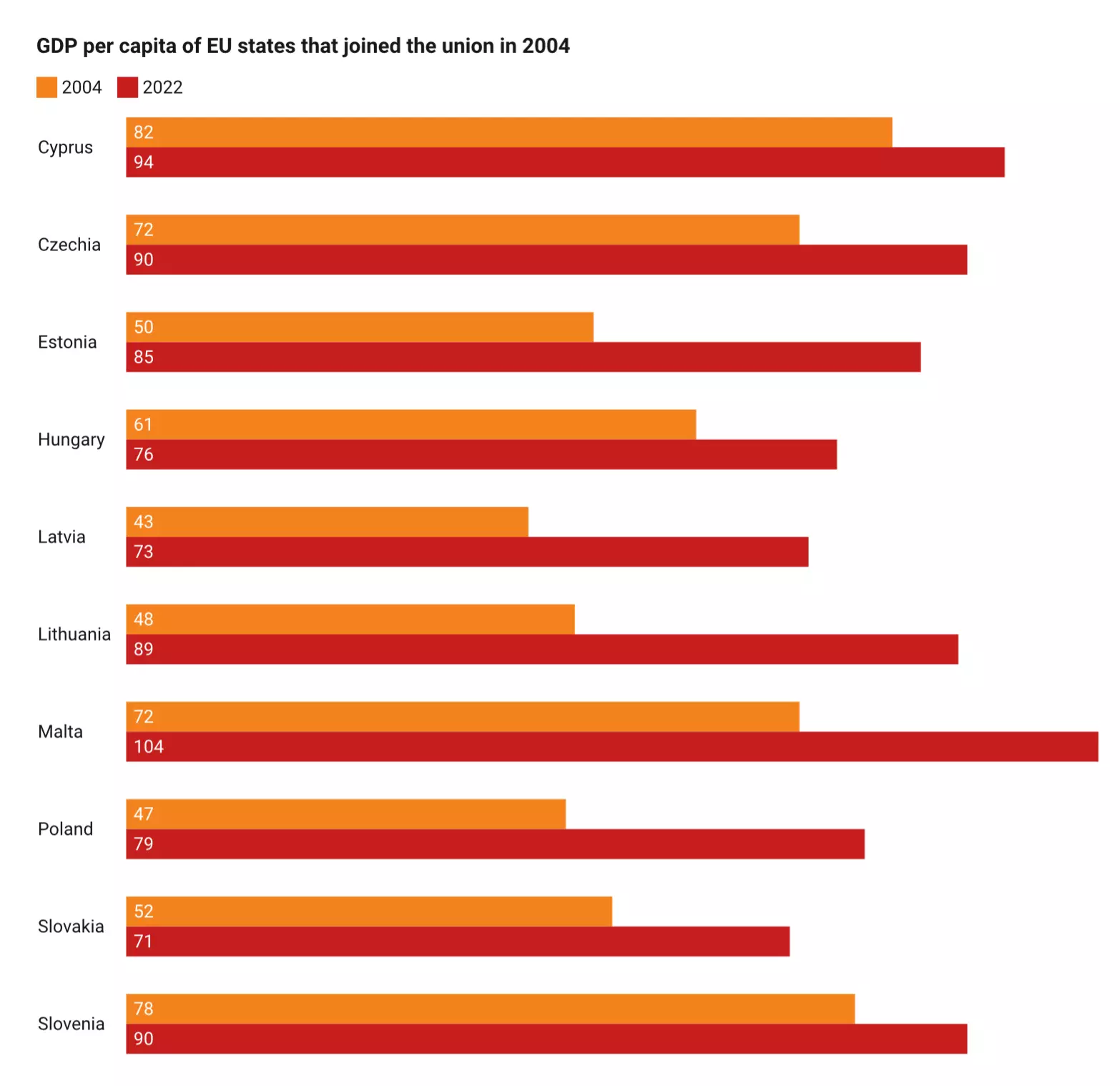 Score measured in purchasing power parities
Score measured in purchasing power parities
Source: European Commission / Get the data / Created with Datawrapper
Framework programme participation
The EU’s newer member states have typically had a harder time winning funding from the highly competitive research framework programmes. This is due to factors such as lack of experience, weaker grant support systems, fewer individual scientific relationships, etc.
The good news is that since framework programme 7, which ran between 2007 and 2013, nine of the 10 countries have increased participation in the EU’s framework programmes. Cyprus in particular has made headway. During FP7 researchers based there won a total of 0.34% of all the programme’s grants, compared to 0.85% in the current Horizon Europe programme.
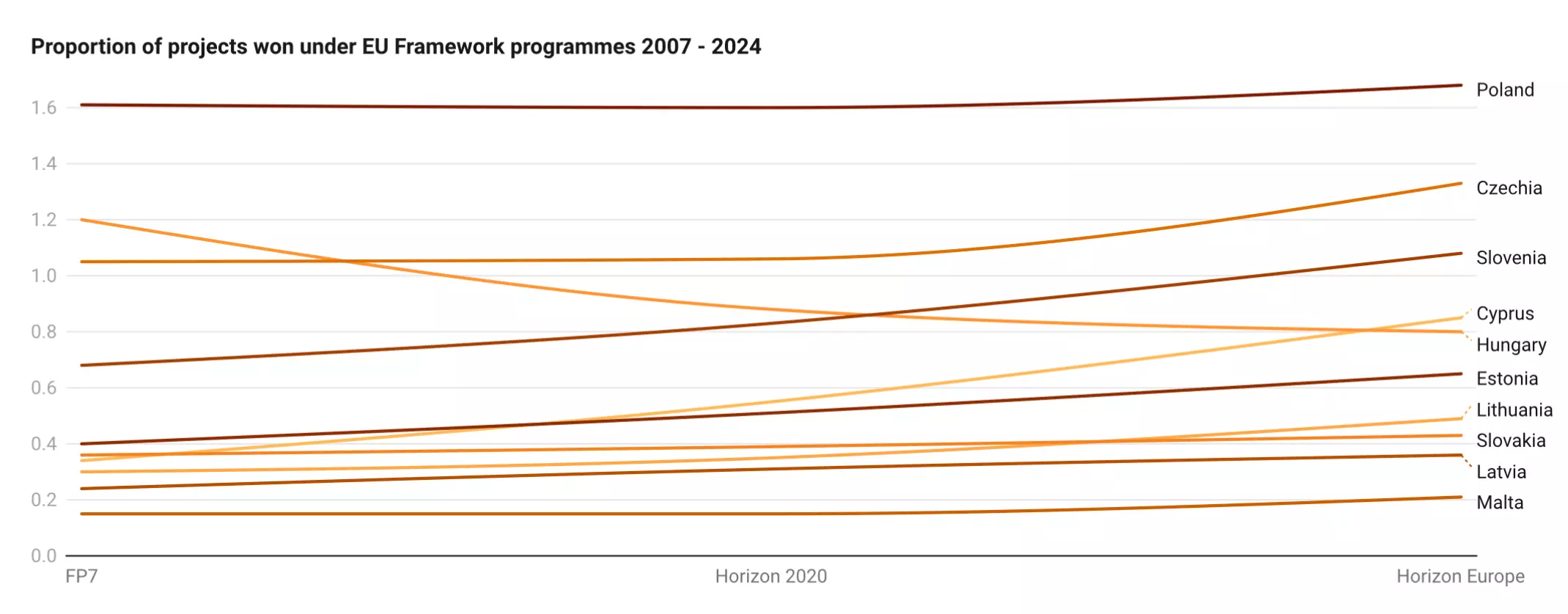 Graph shows percentage of all projects that each country won under the framework programmes. For example, Poland won 1.61% of all FP7 projects awarded.
Graph shows percentage of all projects that each country won under the framework programmes. For example, Poland won 1.61% of all FP7 projects awarded.
Source: European Commission / Get the data / Created with Datawrapper
A notable exception is Hungary, whose participation in the research programmes has dropped from winning 1.2% of projects during FP7 to 0.8% today.
This situation could get worse as over 30 of the country’s institutions, including 21 universities, are currently banned from participating in Horizon Europe due to rule of law concerns about their management structures. There is still no sign of Hungary and the EU coming to an agreement that would see this ban lifted.
The countries that have increased their participation in the framework programmes owe a lot to a different EU funding source, the structural funds that are aimed at levelling up the weakest regions. The European Regional Development Fund (ERDF), one of these, has been particularly useful at helping countries build research infrastructure and universities, and in attracting talent.
Adéla Jiroudková, head of the Research Support Office at Charles University in Prague said these funds have been “crucial” in enhancing scientific infrastructure and facilitating large-scale research projects that were not feasible before our EU accession.
“At Charles University, we have seen first hand how this support has enabled us to upgrade laboratories, attract international researchers, and participate in cross-border research initiatives,” she said.
Tomasz Poprawka, director of PolSCA, the Polish Science Contact Agency of the Polish Academy of Sciences in Brussels, said that EU membership, structural funds and especially ERDF has played a huge role in developing the country’s R&I ecosystem. “A great number of researchers have been supported in setting up their independent laboratories, as well as many talented individuals who were attracted to come and work in Poland,” he said.
On Poland’s participation in the framework programmes, he says improvements are starting to become apparent. “The next 20 years will be different and we’ll have to adapt again, but with the resilience and maturity of the system, we’ll be better prepared to respond,” he said. “I think the best is yet to come with stronger institutions, ongoing reforms, and R&I better prioritised in Poland.”
Kamil Novák, acting head of office of the Slovak Liaison Office for Research and Development in Brussels, also lauded the impact of structural funds. “Since accession, we have been able to invest more than €1 billion […] in our centres of excellence and science parks, which would be very difficult to achieve with our national budget alone,” he said.
But he is worried that the country is too dependent on these funds, which is not sustainable long-term. The availability of structural funds, which are distributed by national governments, discourages Slovakian researchers applying for competitive Horizon Europe funding. Scientists “often feel little motivation to compete for funding at the European level which is wrongly perceived as too complex,” Novák said.
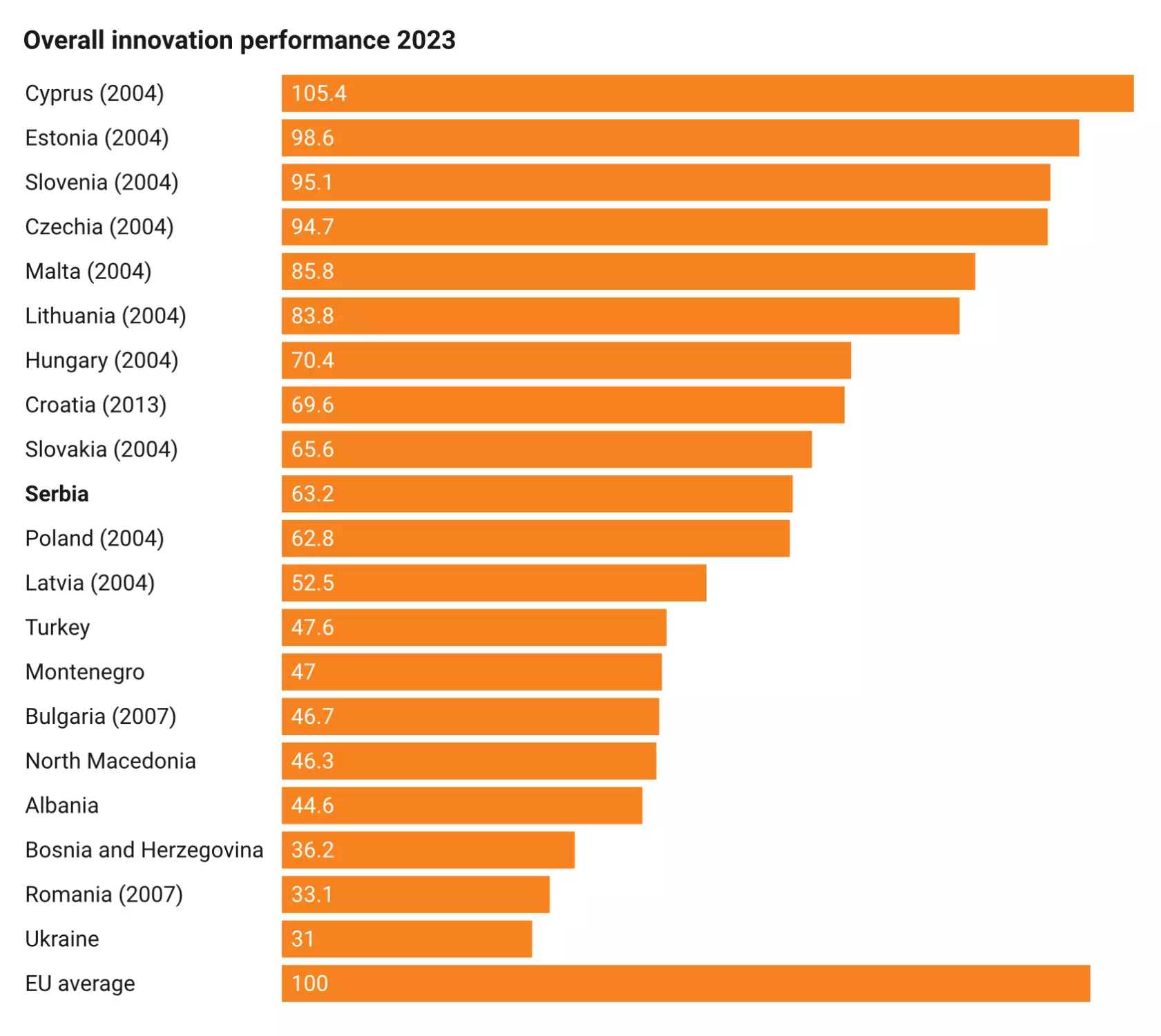 Year the country joined the EU is in brackets if joined
Year the country joined the EU is in brackets if joined
Source: European Commission / Get the data / Created with Datawrapper
The annual European Commission European Innovation Scoreboard provides concrete examples of why EU membership is not necessarily a vital factor in a country having a strong research system. Serbia, which applied for EU membership in 2009 and has been slowly working towards it ever since, has an overall innovation ranking higher than four current EU member states, including Latvia and Poland that joined in 2004.
Of the countries that joined the EU in 2004, only Cyprus scores above the EU average, while Estonia, Slovenia and Czechia are close.
Education
The EU as a whole has been experiencing a sharp decline in new doctorate students in the past decade and that is also true for the 10 countries that joined in 2004. In fact, only Cyprus has seen an increase in new PhD students in the past 12 years.
Comparable data on this metric are only available going back to 2011.
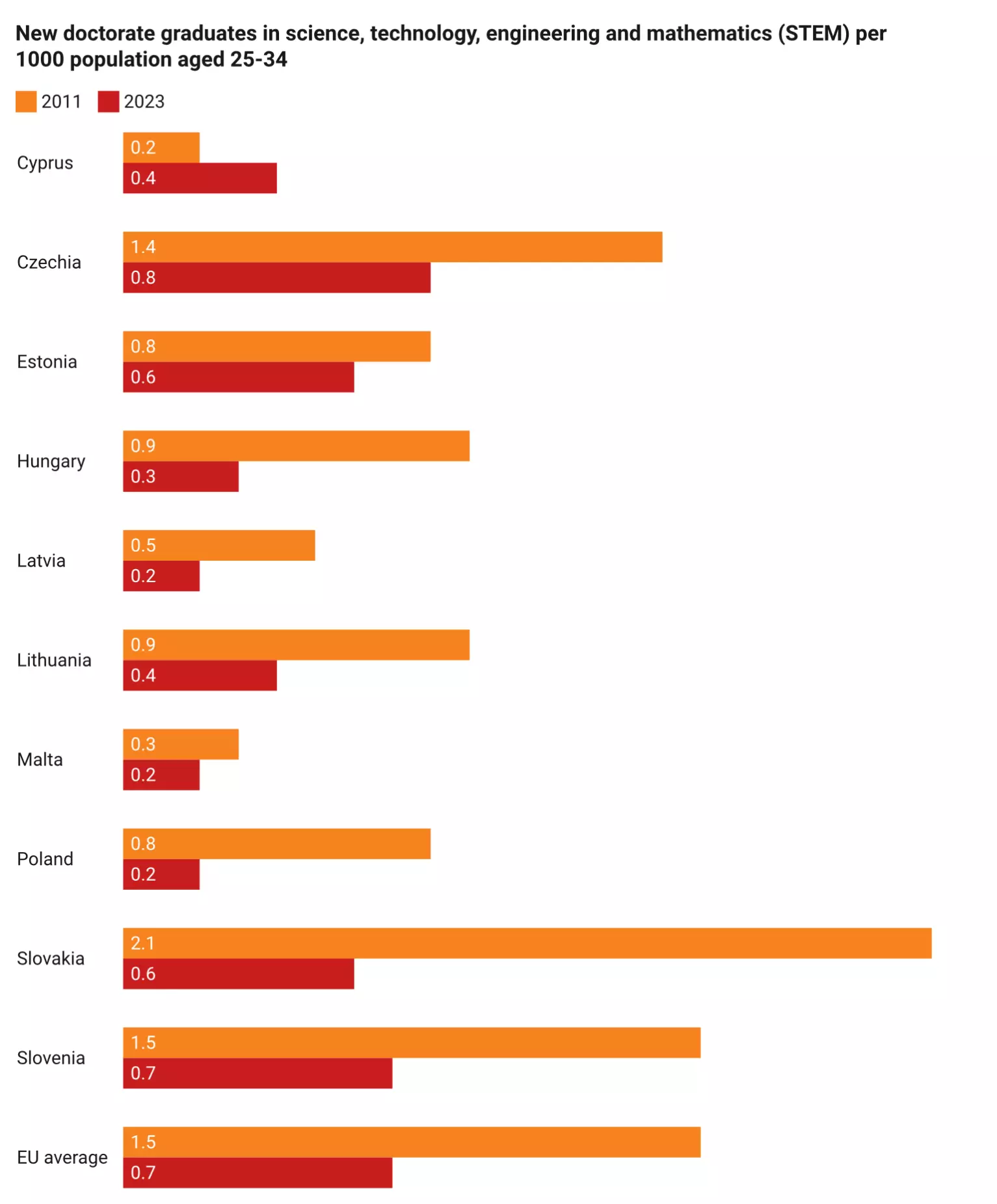 Source: European Commission / Get the data / Created with Datawrapper
Source: European Commission / Get the data / Created with Datawrapper
On a more positive note, the rate of young people entering tertiary education – meaning any form of post-school higher education – has increased across the board in the EU 2004 joiners. Lithuania in particular has seen an impressive rise, and with 58.2% of its young population in higher education, is far above the EU average.
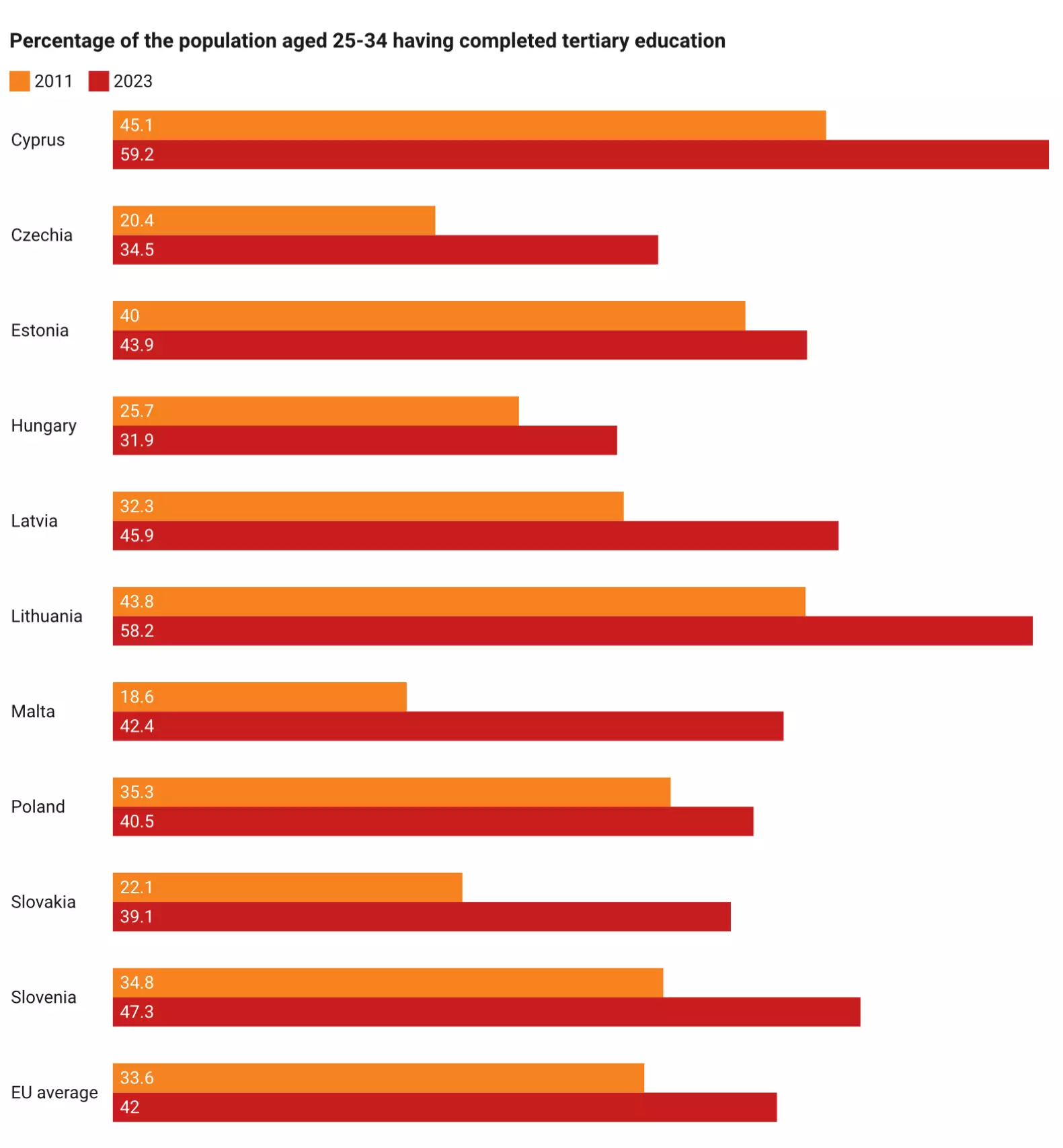 Source: European Commission / Get the data / Created with Datawrapper
Source: European Commission / Get the data / Created with Datawrapper
Patents, papers and partnerships
One way to assess the strength of country’s innovation system is in the number of patents being issued. For the 2004 joiners, it is a mixed bag. In the past 12 years, five have increased the number patents and five decreased. Overall, there has been an EU-wide drop off, and none of the 2004 joiners are producing more patents than the EU average rate.
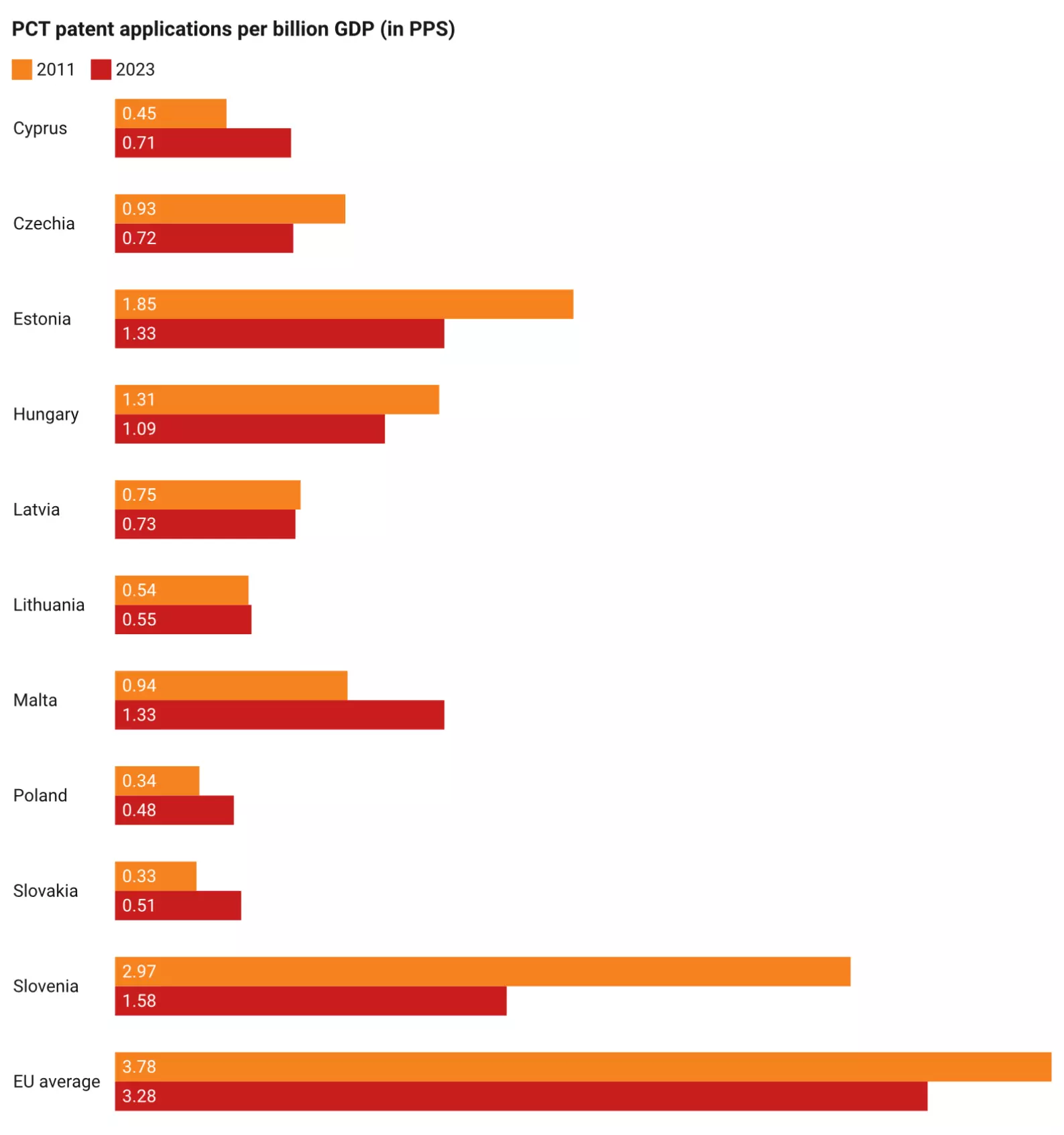 Number of patent applications filed under the Patent Cooperation Treaty, at international phase, designating the European Patent Office (EPO). Patent counts are based on the priority date, the inventor’s country of residence and fractional counts
Number of patent applications filed under the Patent Cooperation Treaty, at international phase, designating the European Patent Office (EPO). Patent counts are based on the priority date, the inventor’s country of residence and fractional counts
Source: European Commission / Get the data / Created with Datawrapper
A clear improvement in the past 12 years is the number of scientific papers that the 10 countries are producing with the help of foreign collaborations. Cyprus and Estonia have in particular improved on this, showing the advantage of EU networking and partnership opportunities.
Ian Gauci Borda, Malta’s national contact point for Widening, ERA, Health, and Research Infrastructures, says the EU has had a role in opening the door to new cross-border scientific partnerships.
“Years of increasing interconnectedness resulted in decreased insularity and increased international participation,” he said. “Our civil society and research communities are now more connected with their European peers.”
He also pointed to Horizon Europe’s Widening measures, which aim to close the EU’s research and innovation gap by funding networking, support, and research activities.
“We acknowledge the importance of the Widening component, which really helps the Maltese research community in its endeavours to improve their research and infrastructure,” Borda said.
This is particularly important because the competition to win EU research funding has increased, making it harder for small countries to keep pace. “We feel that the competition has got stronger with the better proliferation of information about the calls across the EU and particularly the setting up of satellite offices in Brussels which directly deliver information to the right applicants in a very efficient manner,” he said. “Being a small country and economy, we do not have such luxuries and hence [that is] where we struggle.”
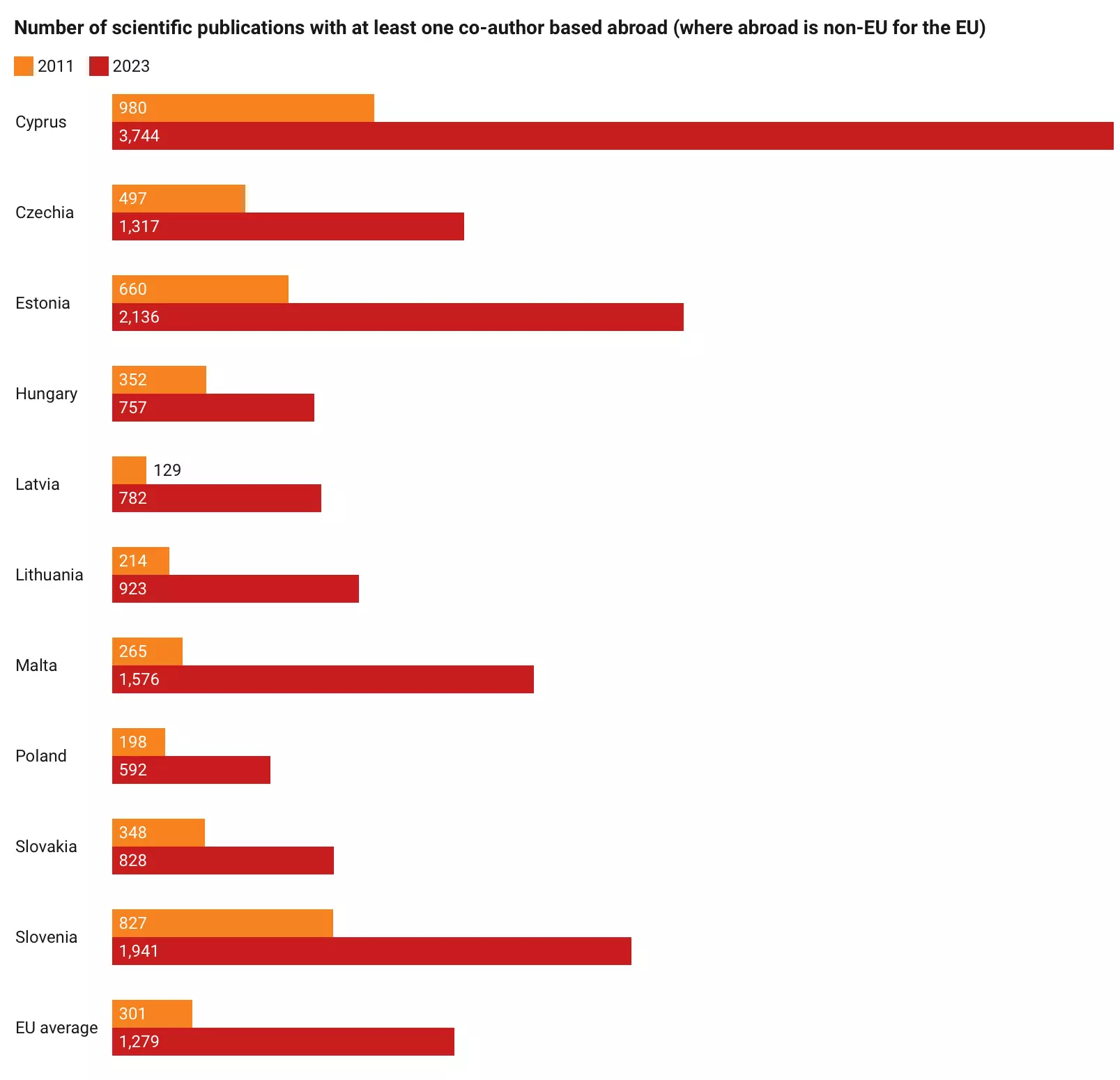 Source: European Commission / Get the data / Created with Datawrapper
Source: European Commission / Get the data / Created with Datawrapper
The EU in the past two decades has put a much bigger focus on public-private R&D partnerships. Since 2011 the number of scientific papers with a public-private co-authorship has increased across the bloc from 36.2 per million people to 138.5 per million.
The same trend is seen across the 2004 joiners, with the increase particularly marked in Lithuania and Latvia, which both had fewer than 10 public-private papers published in 2011.
Tadas Tumėnas, head of Lithuania’s RDI liaison office in Brussels, said there has been a change in research and business culture in the past two decades. “There is greater orientation towards value creation, increased private investments in R&D and internationalisation efforts,” he said. “These changes demonstrate the significant transformation, growth, and improvement of our research and innovation community since joining the EU.”
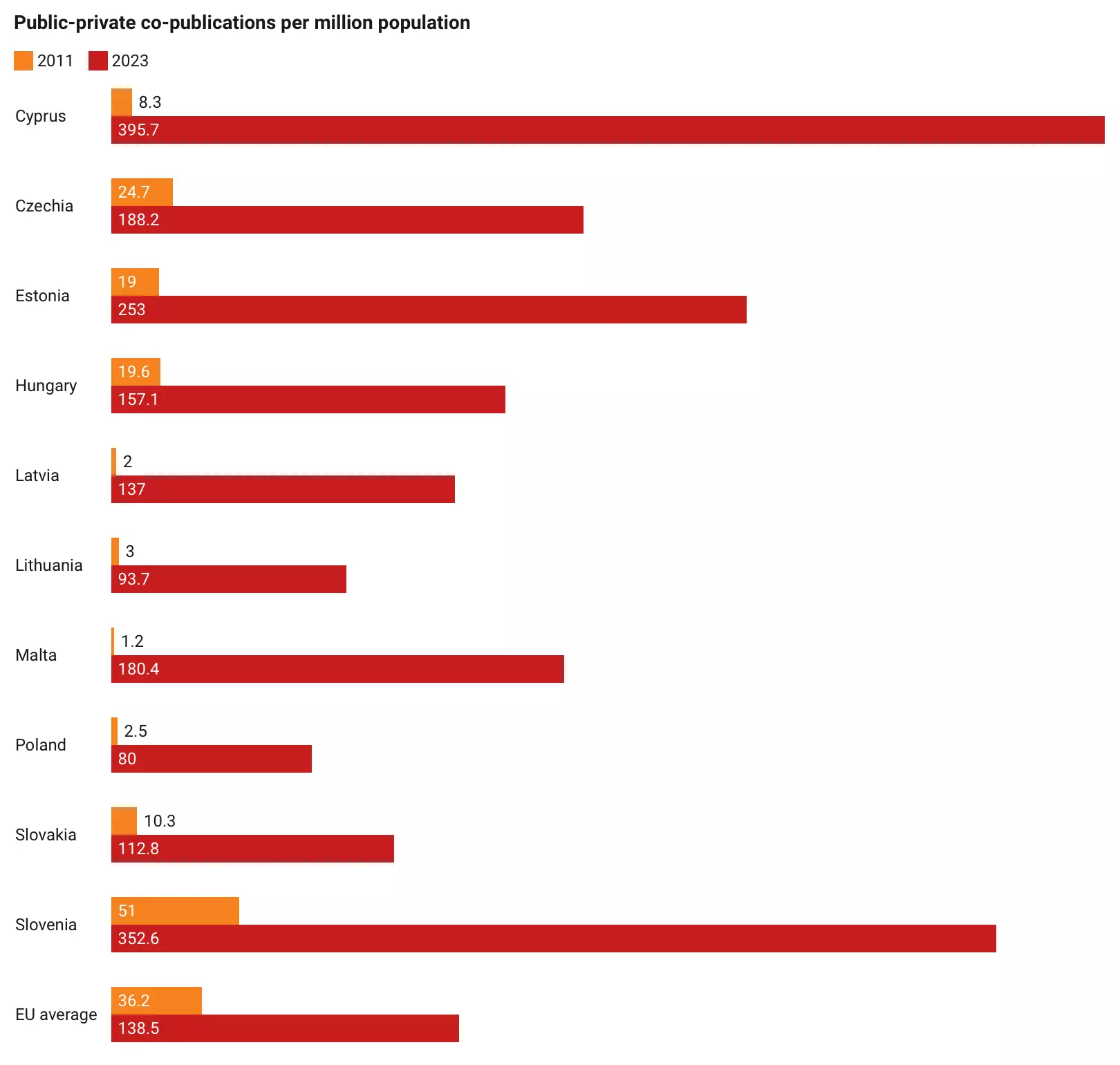 The definition of the "private sector" excludes the private medical and health sector. Publications are assigned to the country in which the business companies or other private sector organisations are located. This indicator captures public-private research linkages and active collaboration activities between business sector researchers and public sector researchers resulting in academic publications
The definition of the "private sector" excludes the private medical and health sector. Publications are assigned to the country in which the business companies or other private sector organisations are located. This indicator captures public-private research linkages and active collaboration activities between business sector researchers and public sector researchers resulting in academic publications
Get the data / Created with Datawrapper
One area that the EU’s newer member states have been particularly weak in is support for business investment in R&D, through mechanisms such as tax breaks, incentives or direct funding.
But change, if slow, is coming. Countries such as Czechia, Estonia, Hungary and Poland are catching up with the EU average in terms of public R&D expenditure in the private sector, while Slovenia is above the average.
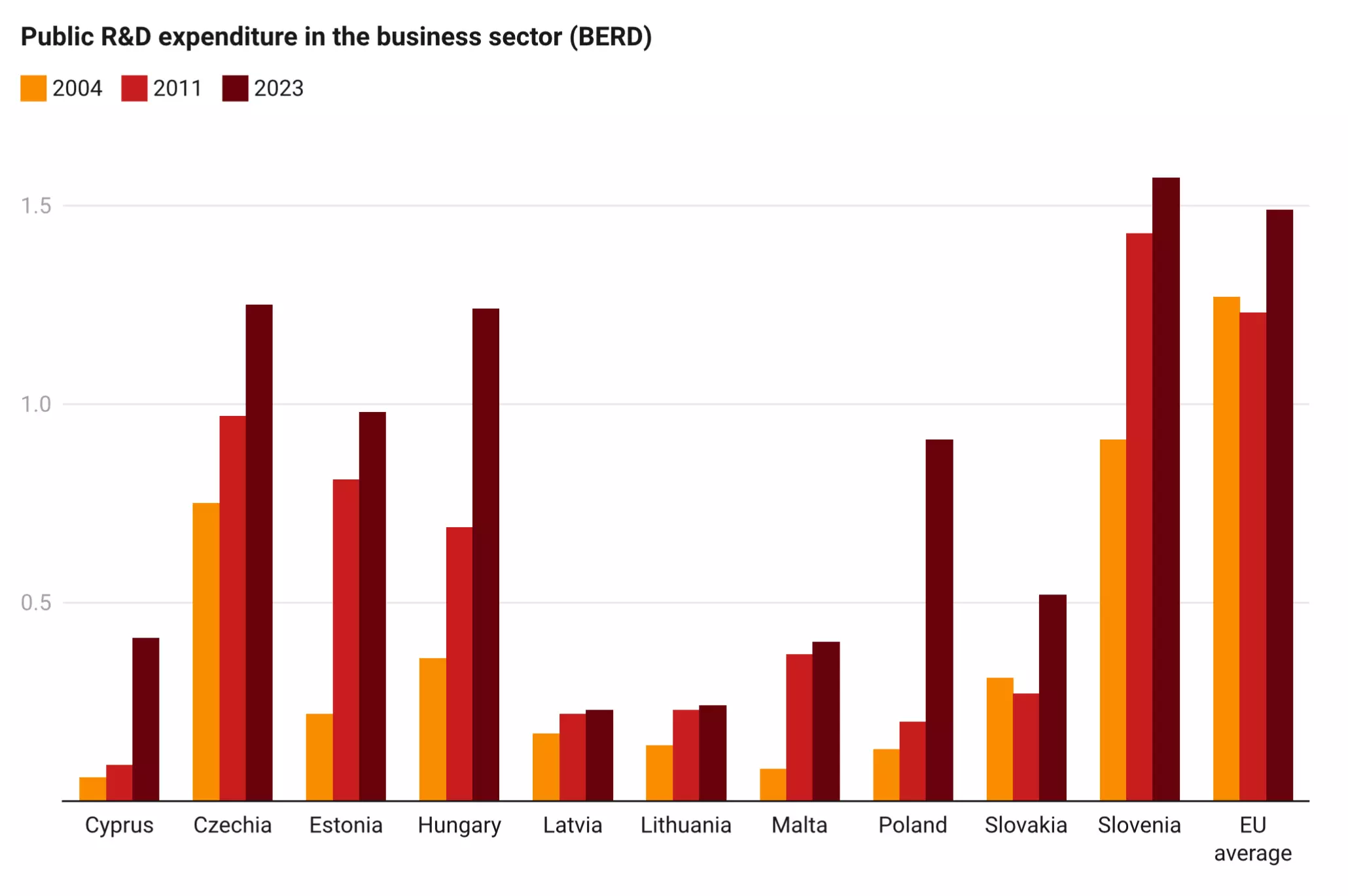 Direct government funding and government tax support for business R&D (percentage of GDP)
Direct government funding and government tax support for business R&D (percentage of GDP)
Source: European Commission / Get the data / Created with Datawrapper
Taken overall, the data show improvements in many areas, but also some signs of stagnation and decline.
“While we have made significant progress,” Jiroudková said, “There is undoubtedly still room for improvement in how we develop these capabilities to fully leverage the benefits offered.”
Autor: Thomas Brent
Zdroj: Science Business
- Autor článku: ne
- Zdroj: Science Business








































